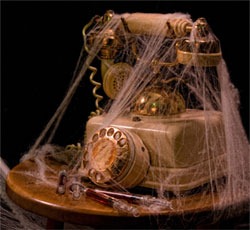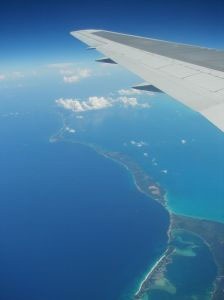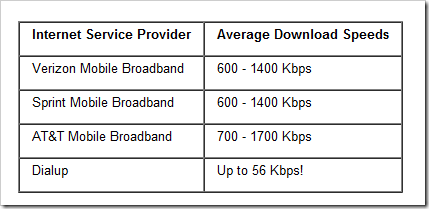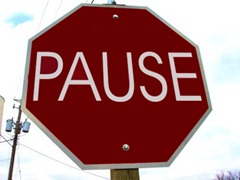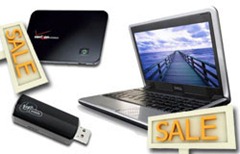Learn How Mobile Broadband Can Free You From Overpaying For Snail’s Pace Dialup
Does any of this sound familiar?
Our best dial-up speed has been 24k, usually it’s 21.4. We tell people we have rusty barbed wire for phone lines.
– Mark
"It took me all of thirty (30) minutes to get you this information with my dialup connection"
– James
" I live in a rural area and have been stuck on dial up for many years".
– Chris
"It takes 9-12 hours to just update my Mac OS- only to have the computer terminate internet connection 3/4 way thru. Can’t afford Satellite. All I have is dial up now. There’s no cable or fiber optic on my island.".
– Julie
"I live in a remote (no cable service), wooded (trees too tall for satellite dish) area, so dial up is my only other choice".
– Mike
"I currently have dial-up and they’re not going to expand DSL to my location even though I’m within range of a site".
– Perry
"Dial up in the country is slow. I can not receive pictures from my grandchildren. My server times out trying to download them".
– Nola
"Need faster downloads than miserable dial up with 56k modem, and my only other option is monopolized cable. I don’t need video games, just decent web surf and download speeds".
– Steven
"Live in the boonies, my son wants to play PS3 online and fed up with dial up"
– Neal
shudder…
To be perfectly honest with you, I don’t live in a rural area.
As a matter of fact, I have access to satellite broadband, cable broadband, DSL, mobile broadband and yes, even dial up.
In short, I’ve got options.
However, it wasn’t always that way.
An Island of Dial Up
Here’s an unpublicized tidbit on me.
I’m from Jamaica.
Not Jamaica, Queens, New York (no offense). I’m talking about the one where it doesn’t snow and the people wear jackets when it hits 70 degrees to keep from getting sick.
Besides Bob Marley, white sand beaches, and the most flavorful jerk chicken you’ll taste, for a long time we also had…
(*cue horror music)
Dial Up!!
(Dum Dum Duuummmm!!)
That was back in 2000. Thankfully, things have changed. Not only is it common for many places to have DSL, quite a few are now hooked up with cable and fiber optics thanks to an submarine fiber optic cable surrounding the island.
Pretty fancy for a ‘3rd world’ / developing country huh?
"Come to Jamaica and feeeeeel allll riiiight" (Shameless sales pitch for my country)
So What’s The Problem?
So the question is this:
If a country who’s exchange rate is projected to hit $100 to $1 US dollar in 2010 can have fiber optics, cable and DSL, why the heck are people suffering with dialup in this country?
In one word it’d have to be:
Size
The United States is a pretty big place. It’s not incredibly uncommon for someone to live a full life without even having to leave one state (e.g. California).
While great for cultural experiences, America’s diversity in topography creates a difficult challenge for getting internet.
If you can think of a landscape, America’s got it:
- Desert
- Mountains
- Frozen Tundra
- Deep Forests
- Large Open Plains
- Hurricane Prone Areas
Interestingly enough though, just as there are many landscapes, there seem to be that many ways of getting online. However, each way of getting online can be challenged by one of the above environments:
- Dial Up via telephone lines (need a telephone wire and really slow)
- Broadband via Satellite (available everywhere but expensive/unreliable)
- DSL via telephone lines (limited availability in rural areas)
- Cable via wires (limited availability in rural areas)
- Fiber optics via wires (definitely not available rurally)
- Mobile Broadband (available anywhere you’ve got good cell phone service)
Now, this is decades old news to you if you’re in a rural area. You didn’t need me to tell you things like:
"I’m stuck with dial-up as there is no DSL or Cable"
– Thelma
"For me there was only Dial up or Satellite of which I have heard too many bad things".
– Gary
"1) Dial up Sucks 2) Satellite is no better 3) Rural and no other services available"
– Dave
"I am tired of slow dial up internet service".
– Donna
Questions That Need Answering
Instead, you need to know things like:
- How much does mobile broadband cost?
- How much faster than dial up is it?
- Will I get a good coverage/signal where I am?
- Do I have to go with my current cell phone company?
- Can I play games like World of Warcraft or use my PlayStation 3 with it?
- Can I use it for my entire family or just one person?
- If I live in fringe area with terrible signal, can I get a booster antenna to get better coverage and speed?
- Will these 5 Gigabyte caps be enough each month?
- If I get it and don’t like it, can I return it without being locked into some silly 2 year contract?
No problem. Those are the same kinds of questions I asked myself when I first got mobile broadband.
If you’ve got dialup right now and are thinking about mobile broadband, pay very close attention to the next section:
5 Steps To Ditching Dial Up For Mobile Broadband
There are 5 steps to ditching dialup for mobile broadband you need to cover.
By going through these steps, you’ll learn everything you need to know about mobile broadband before, during and after you buy so you can make the best decision.
If you don’t go through these steps, you run the risk of getting mobile broadband but not having it work (and being stuck in a 2-year contract). If you don’t fully do your research, you could end up paying $60 a month for mobile broadband but still have crappy dialup speeds.
Let’s avoid that.
Step 1: Find Out If Mobile Broadband Speed & Coverage is Available In Your Area
I’m going to be a bit presumptuous. If you’re reading this, I assume that you live in a rural area with few or no other options for mobile broadband.
With that being said, you’ll need a provider that offers next to the best coverage as well as speed all over the United States.
While there’s a whole fruit basket of mobile broadband providers out there, only 3 have large enough networks that’ll get the job done.
Verizon, Sprint & AT&T.
You may have heard of them.
Verizon and Sprint are the kings of mobile broadband coverage. They’ve invested wads of cash in the hopes of getting people like you and me to give them money each month. While AT&T would like the same, their coverage isn’t as spectacular.
At the time of this ad, Verizon had 5 times the 3G coverage of AT&T.
So why include them if their coverage is so crappy?
Easy. There are still a couple places that AT&T has coverage while Sprint & Verizon do not. Sometimes its just the luck of the draw.
So How Do You Check?
Verizon 3G Coverage Map – select ‘Broadband & V Cast’, refresh the map and plug in your address
Sprint 3G Coverage Map – select ‘Data, Email and Multimedia’ and plug in your address.
AT&T 3G Coverage Map – select ‘Data’ (if not already highlighted) and plug in your address.
Make a note of who’s got the best coverage in your area. For a more rugged test, see if you or your friends have 2 or more bars of cell phone service with each/any of the providers.
If service is poor, see "Step 2" for improving coverage/speed
What About Mobile Broadband Speed?
Here’s the super summarized need-to-know info:
*while mobile broadband can have bursts of speed up to 3.1 Mbps, rural/fringe areas are less likely to get these. As such, they’ve been excluded here to avoid any potential sales hype.
In other words, on the conservative side, mobile broadband is ten times faster than dialup.
Step 2: Improve Coverage/Speed In Bad Service Areas (If Necessary)
There may be a chance that you live in a rural fringe area with poor signal. If that’s the case you may need a mobile broadband booster antenna to improve signal (which in turn improves speed).
Now the big question is, how do you figure out if you even need one or if it’ll help?
Luckily, the guys over at EVDOinfo.com (EVDO Blog & 3GStore) have put together some stellar information. I’ve gone ahead and read it all to pick out only the relevant stuff to help you stay on course in the sea of information out there.
Here’s the steps you need to take:
Muy Importante!
The following links take you from this site. While I encourage you to purchase a mobile broadband antenna if you need one (I will make money from it), do not purchase your broadband card there.
I will provide a link at the end of the article to another one of our partners that has the best deals hands down for broadband cards (every card is free and you can make up to $100 from some of them). However…
Do not buy anything just yet.
If you do, you run the risk of ending up with a $590 mobile broadband bill of overage charges. To avoid that, you’ve got to read the next step on whether 5 Gigabytes is enough for you.
Without further ado, on with the show
4 Specific Steps To Get Better Coverage
1. Find out if a mobile broadband antenna will help you (by doing a site survey to find out signal strength):
2. Find out which antenna is best for you or:
3. Go to the 3Gstore pick an antenna based on your mobile broadband card
4. Get the actual broadband card for free through our partner (I’ll give you the link at the end of this article. Each step is vitally important).
Bonus Info:
If you’re not sure if the broadband card you’re interested in has an antenna jack to plug into, check this list to see a picture of where the antenna jack is located on the broadband card you’re interested in.
Step 3: Find Out If 5 Gigabytes Is Enough
While there are a bevy of mobile broadband providers, most of them won’t make the cut if you live in a rural area. You’ll need the best in speed and coverage (and maybe even an antenna booster from above) to make it work for you.
There’s one caveat though.
The 3 big providers (Sprint, AT&T and Verizon) all have 5 Gigabyte caps. If you go over these caps, they want stupid sums of money from you. To avoid that, I’ve put together a short article
What Can I Do With 5 Gigabytes?
After reading and figuring out if 5 Gigabytes will do it for you. The final step before getting mobile broadband is having an exit strategy.
Step 4: Have an Exit Strategy
"An exit strategy is a means of escaping one’s current situation, typically an unfavorable situation.
- Wikipedia
In other words, your exit strategy is what you do when s*** hits the fan.
Will it? Probably not after all this preparation you’ve taken. The real reason however is this:
The Mobile Broadband Buyer’s Guide explains what you need to know, before, during and after buying mobile broadband. Having an exit strategy before you even get it prevents any potential worry of "what do I do if things don’t work out".
Now that you know what an exit strategy is and why it’s important, what will your exit strategy be?
Here’s Your Exit Strategy
When you decide to get mobile broadband below, try it for about 7 days. That’ll be enough time to figure out if you like it and want to keep it. If you do, then great.
However, if you don’t like it, return it within 15 days for a full refund (if you paid anything at all) in accordance with this return policy. You will also need to cancel your plan.
Step 5: Everything Checks Out? Well Get The Darn Thing Already
Now that you’ve:
- Checked mobile broadband coverage in your area
- Figured out if you need a signal boosting antenna
- Learned that 5 Gigabytes is enough for you
- Gotten familiar with your exit strategy
You can:
1. Order Your Broadband Card for Free (it does benefit the site)
2. Get a Booster Antenna if you need one (select antennas in the left sidebar. Oh yeah, this is an affiliate link as well)
3. Test it for 10 days. If you don’t like it for whatever reason, return it following these guidelines.
4. Let me know how the ditching dialup is going for you at the bottom of this page

